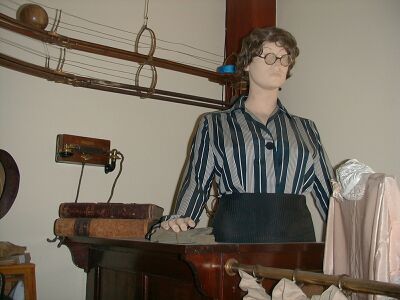How and why they were used
In the shops of the nineteenth century, it was usual to have a single cashier
(or cashier's office) to receive all payments taken by the salesmen and to issue
change. This meant that only one trustworthy cashier was needed (presumably
at a higher salary) to handle the cash and record transactions and the temptation
for the salesmen to pilfer was removed. It also kept customers at the salespoint,
avoiding congestion in an age when ladies wore voluminous clothing - and of
course they might decide to make a further or better purchase. To save customers
the inconvenience of having to go to the cashiers in person, cash boys or cash
girls were sometimes employed to carry the payments and change (see Adams). In Crystal River, Colorado, the wages of $2.50 to $3 per week were typical and girls were preferred to boys.
Lamson's booklet The Story of a Service Idea (1912) gives a calculation of the financial benefit of a pneumatic tube system. For a large department store with 200 stations the cost of the complete plant would be about $50,000 which would ordinarily be written down at $5,000 per year. This, plus interest at 5% (which would amount to $2,500) and $1,250 per year for power, represents a first year cost of $8,750 with reduced interest as time goes on. The alternative of employing at least 300 cash boys or girls, costing a minimum of $3 per week, would be a wage bill of $46,800 p.a.
|

Photograph © Leicester City Museums Service, 2001
|
In the mid-1870s inventors turned their minds as to how this operation
might be automated. It is said that in William Lamson's shop at Lowell,
Massachusetts, the salesmen used to tie the cash up in a handkerchief
and throw it across to the cashier! He then came up with the idea of using
a wooden ball, like a hollowed-out croquet ball, which could be taken
apart into two halves. The money was placed inside, held by a spring,
the ball was assembled, and then put on a track (originally an animal
feed trough?) which sloped down to the cashier. The cashier dealt with
the transaction and returned the receipt and any change along another
track which sloped the opposite way down to the sales point. Other shops
wanted similar systems and Lamson founded a company in Boston which within
a few years spread around the world.
|
The Cash Ball system was followed by the cable system, in which the carrier
was clamped to a continuous moving cable. This was popular in America but I
have traced only a few installations in Britain. Here the wire system was preferred,
where the money was placed in a wooden cup which could be screwed to a trolley
running on one or two wires. It was propelled either by a catapult-type device
at each end (Lamson's Rapid Wire system) or by pulling apart the two wires at
the sending end (Gipe's). These were in turn succeeded by the pneumatic tube
system. The money was placed in a cylindrical canister that was propelled through
a tube by a difference in air pressure. Large department stores had hundreds
of tubes converging in the cash office.
According to the American Patent Reports (quoted in a letter to the Blackburn Weekly Standard and Express, 11 Feb. 1899, p. 10) there were three leading firms in the United States in 1895 renting out 30,000 cash carriers.
The downfall of the cash carrier came with the widespread use of cash registers
and then the rise of the self-service store. The principal inventor of the cash
register was James Ritty for his saloon in Dayton, Ohio. It allowed security
of cash handling at each sales point rather than at a central office. Ritty
and his colleague John Birch sold their business to what became the National
Cash Register Company in 1884 (Liffen). Self-service
stores started in America in 1916 and took off in Britain with Co-ops in the
1940s.
Clyde Phelps in Retail Credit Fundamentals (McGraw Hill, 1947) stated that at the outbreak of World War II there were still about 4,000 users of each type of system (basket, cup and cable) but manufacture had been discontinued in favour of "more modern methods" such as pneumatic tubes. Now only a few cash carriers remain in service, mainly as curiosities, and
there are some in museums. But similar pneumatic tubes are still in use for
other purposes and for carrying cash in bulk from checkouts to secure storage
in supermarkets.
